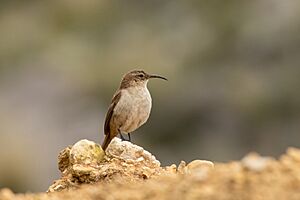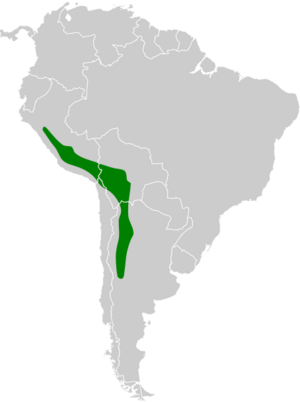Buff-breasted earthcreeper facts for kids
Quick facts for kids Buff-breasted earthcreeper |
|
|---|---|
 |
|
| Conservation status | |
| Scientific classification | |
| Genus: |
Upucerthia
|
| Species: |
validirostris
|
 |
|
The buff-breasted earthcreeper (Upucerthia validirostris) is a type of bird. It belongs to the ovenbird family called Furnariidae. You can find this bird in Argentina, Bolivia, Chile, and Peru.
Contents
About the Buff-breasted Earthcreeper
The buff-breasted earthcreeper is a medium-sized bird. It measures about 17 to 21 cm (7 to 8 inches) long. It weighs between 30 and 45 grams (about 1 to 1.6 ounces). This bird has a long, curved beak. Male and female buff-breasted earthcreepers look very similar.
What it Looks Like
Adult birds have a pale, yellowish-white stripe above their eyes. Their head, neck, and back are a dull brownish-gray color. Their tail is dark brown, with more reddish-brown feathers towards the outside. Their wings are mostly brownish-gray, but with some reddish-brown near the base of the main flight feathers.
Their throat is grayish-white with small brown spots. The upper part of their chest is grayish-white with a scaly, brownish look. The lower chest, belly, and feathers under the tail are a plain light yellowish color. Their eyes are dark brown. Their beak is blackish, with a lighter color at the base. Their legs and feet are dark brown or blackish. Young birds look like adults but have clearer markings on their chest.
There are different types, or subspecies, of this bird. One type, called U. v. jelskii, has a smaller, shorter beak. It also has less reddish-brown in its wings compared to the main type. Another type, U. v. saturata, is similar to jelskii but has grayer feathers on its underside.
Where the Buff-breasted Earthcreeper Lives
The buff-breasted earthcreeper lives in the Andes mountains. The U. v. jelskii subspecies is found in many places. It lives from Peru, south into Chile, and through western Bolivia. It also lives in northwestern Argentina.
The U. v. saturata subspecies lives in the western Andes of central Peru. The main subspecies, U. v. validirostris, is found in northwestern Argentina. It lives from Salta Province south to Mendoza Province. It also extends east into western Córdoba Province.
Its Home Environment
This bird prefers to live in high grasslands called puna grassland. It also lives in dry, mountainous areas with lots of shrubs. Within these places, it likes dry valleys with thick bushes. It also enjoys rocky and bushy slopes. It usually avoids flat ground.
How the Buff-breasted Earthcreeper Behaves
Staying in One Place
The buff-breasted earthcreeper stays in the same area all year round. It does not migrate.
What it Eats
This bird eats arthropods, which are like insects and spiders. It eats both adult arthropods and their young (larvae). It usually looks for food alone. Sometimes, you might see a pair foraging together. They search for food by poking their beaks into the ground. They also pick food off the ground.
Breeding and Nests
The buff-breasted earthcreeper lays eggs during the summer in the Southern Hemisphere. This is usually between November and March. The exact timing can be a bit different depending on the region. Scientists believe these birds form pairs for breeding.
They build their nests in a special chamber. This chamber is at the end of a burrow dug into an earthen bank. Sometimes, they use a crack in rocks instead. They line the nest with soft grasses. A female bird usually lays two eggs. We don't know how long the eggs take to hatch. We also don't know how long it takes for the young birds to leave the nest. Details about how the parents care for their young are also not fully known.
Bird Calls and Songs
The buff-breasted earthcreeper is not a very loud bird. The main subspecies has a song that sounds like a long, dry trill. It's made of about 10 or more "tyik" notes. Its call is a low "chwit".
The other two subspecies have a different song. It's a rich, uneven trill that sounds like "drrrrrr…". This song can last from one to over ten seconds. It starts high, then gets lower in pitch. It also speeds up, then slows down. Their call is a metallic "click" or "tyi-ík".
How the Buff-breasted Earthcreeper is Doing
The IUCN (International Union for Conservation of Nature) has looked at the buff-breasted earthcreeper. They have listed it as a species of "Least Concern". This means it's not currently in danger of disappearing.
It lives across a very large area. However, we don't know exactly how many of these birds there are. Scientists believe their numbers might be going down. No big threats have been found for this bird right now. It is considered rare in some places, but fairly common in others. Its home environment is generally safe from human activities. The only possible issue is too much grazing by farm animals.


